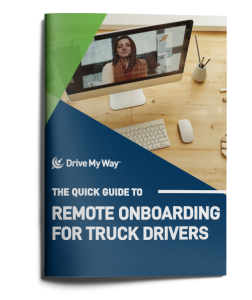
Let’s call a spade a spade. 2020 has been a year full of surprises and challenges. As an employer in the trucking industry, you may have a front-row seat to the hardships of Coronavirus. As you’re navigating these uncharted waters, be proactive in reaching out to your entire staff. This is not business as usual, and silence will be noticed. Take this opportunity to firmly demonstrate that your company cares about drivers. Focus on driver care, and you will build positive, lasting relationships for years to come. Here are just a few ways to show employees that you value them as people as well as for their work.
1. Clear Communication
Be transparent and proactive with driver communication. It is one of the best ways to demonstrate driver care during COVID-19. Good communication is increasingly important because face-to-face interactions are scarce and can be hard to facilitate.
As you navigate the many transitions of this year, integrate driver check-ins as a regular priority. Ask drivers what form of communication works best for them.
While you may prefer emails, your drivers may feel more connected through phone calls, video calls, or texts. Show them you care by reaching out in the way they prefer, even if it’s not your most natural communication channel.
2. Truck Sanitation

As essential workers, truck drivers are keeping our country moving. As a fleet manager, you know that keeping drivers safe and healthy needs to be top of mind. Even as other industries slowly reopen and stay at home orders are lifted, the danger is not gone. Make a plan for sanitizing fleet equipment.
If you haven’t already, consider sending drivers out with the resources they need for their day to day work. Masks, hand sanitizer, and cleaning wipes go a long way toward making drivers more comfortable. Regardless of what you decide, clearly communicate with drivers what you are doing and your expectations for them. If you ask drivers to bring their own supplies, consider reimbursing their purchases.
3. Mental Health
A life on the road has its fair share of loneliness for anyone, but COVID-19 adds unique stress. Often, drivers are working increased hours or are completing more runs. The pressure for on-time deliveries is high. In addition, many drivers are deeply concerned with the well-being of their loved ones.
The same home time that is often a relief may be equally or more stressful than being on the road.
As a result, even when they come home after a few days or weeks on the road, family time may be very different. Some drivers intentionally quarantine themselves when home to reduce the risk of spread. As you check-in with drivers, provide them with resources to help connect with spouses, children, and friends.
4. Company Culture
Perhaps ironically, challenging times often provide the clearest moments for demonstrating strong company culture. Focusing on driver care helps build relationships throughout your organization. It’s also an effort that will leave a lasting impression on your drivers. Treat them well, and you will reap the benefits for years.

Drive My Way feature of Driver Dee from Prime Inc.
There are both public and private ways to prioritize driver care. In the public eye, use this opportunity to visibly thank and showcase drivers. If you maintain social media accounts or share a regular newsletter, use your platform to elevate drivers. Trucking is often a thankless job. Even though many Americans are now publicly thanking drivers, company recognition goes a long way. Consider launching a driver showcase series where you spotlight one stand-out driver each week. Then, you’re boosting morale and offering other drivers a model of what a top employee looks like.
Private appreciation of drivers can take many forms. In addition to your regular driver check-ins, consider writing short, personalized notes. Alternately, pack lunch bags or coolers for drivers. It’s no secret that a healthy life on the road is harder than ever right now.

Sending drivers with a cooler shows that you care and you understand their challenges. If you’re not sure where to start, ask for feedback. Most drivers are all too happy to share their suggestions for improvement. Are drivers happy with how communication and health concerns are handled? Thoughtfully consider the suggestions that are offered. Then, choose a few to implement as soon as possible. Being responsive to driver questions and concerns is a form of driver appreciation.
The Long and the Short Of It
As we move into the second half of 2020, experts forecast that companies should prepare for the continued effects of COVID-19. Now, you have time on your side. A focus on driver care necessitates both short and long term planning. In addition to your ongoing efforts to support drivers now, start developing a relief plan for the future. Consider, what would you have done differently this spring if you had been given 4 months warning? Take advantage of your experience this spring and develop a plan to sustain your company and support drivers in the event of a second wave.













